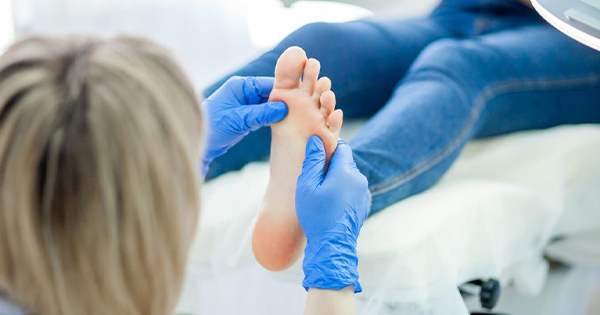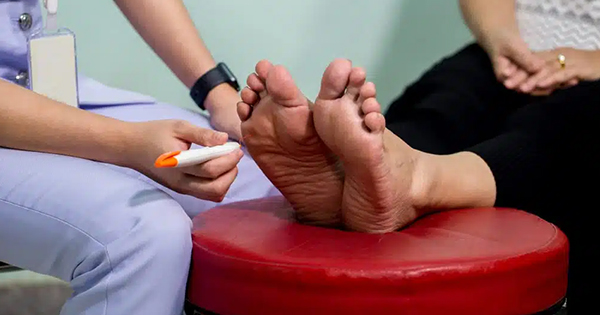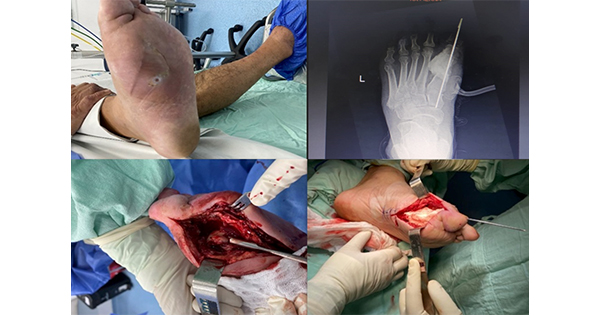Diabetes is an increasing global health concern. In the UK, more than 5.6 million people are living with diabetes. The figure is expected to rise by 1.3 million by 2050 (NHS England, 2024). Foot problems are one of the most common causes of hospital admissions among patients with diabetes, and 25% patients with diabetes may develop an ulcer during their lifetime. Research indicates that 85% of all lower-limb amputations in patients with diabetes may have resulted from foot ulcers (Lauterbach et al, 2010).
This study aimed to explore patients’ understanding of proper foot care on the prevention of diabetic foot infections in patients with diabetes.
Methods
Patients attending the diabetic foot clinic were asked to complete a questionnaire which consisted of both factual and perception-based questions to assess their knowledge, attitude and practice (KAP) regarding infection control and prevention of diabetic foot ulcers. Questions ranged from assessing patients’ basic knowledge of infection control such as hand hygiene and the use of alcohol-based hand gel to evaluating perceptions of proper foot care.
Results
Thirty-three patients with diabetes participated in the study, with ages ranging from 28 to 99 years (median age: 63 years; Figure 1) and 42% of them were female. Foot ulcers were present in 82% of patients and most (81%) had type 2 diabetes.
The KAP questionnaire was designed to assess fundamental knowledge and practical approaches to infection control, reflecting the basic standards we expect patients with diabetes to acquire over time. With an average diabetes duration of 17.8 years (range: 9– 40 years), the average KAP score of 9.60 ± 0.9 (IQR: 1) suggests that most participants have internalised essential infection control practices.
Age and diabetes durations were divided into two groups based on the median value (Figure 2). KAP scores ranged from 7 to 11, and three participants scored full marks. We observed a slightly higher average KAP score in patients assigned to the elder (≥63 years)group (9.65 versus 9.54). Male patients achieved a higher average KAP score when compared with female patients (9.90 versus 9.36). Patients with type 1 diabetes performed better than those with type 2 (10.0 versus 9.25) in the questionnaire. A higher average score was also seen in patients with relatively longer diabetes duration (9.65 versus 9.77). The greatest difference was seen when comparing patients with and without history of foot ulcer – superior result was seen in patients with a positive history (9.81 versus 8.50).
Knowledge
- All patients recognised the importance of hand washing in prevention of the spread of infection
- 87% of the patients knew that they should wash their hands for at least 20 seconds with soap and water
- 75% of the patients realised that alcohol gel is not an alternative to soap and water when hands are visibly dirty [Figure 3]
- 53% of the patients had knowledge of the use of alcohol hand gel for cleaning
- 80% of the patients correctly pointed out that exposing a wound to air does not aid healing
- More than 90% of the patients recognised that showering with a diabetic foot ulcer does not help keep the wound clean, and washing the ulcer with soap and water does not prevent bacterial infections
- All patients appreciated the importance of hand washing before and after dressing changes.
Attitude
- 96% of the patients appreciated the use of moisturising cream in preventing cracks in their feet
- 98% of the patients agreed that dry dressing should be applied whenever there is any break in the skin
- 98% of the patients recognised that they have to take antibiotics and complete the full course as prescribed to prevent bacterial resistance.
Practice
- Most patients had a practice of regularly washing their hands. The indication is very satisfactory, but there is room for improvement in the awareness of the use of alcohol gel
- All patients expressed that they adhered to the wound care practices advised by the physicians. The adherence to proper wound care practices was high, reflecting patients’ general understanding of the effectiveness of infection prevention measures.
Discussion
The questionnaire was aimed at exploring patients’ factual knowledge of and attitudes towards infection prevention. In particular, specific items that assessed practical knowledge: Q3 (‘To clean your hands properly, you need to use alcohol hand gel for at least 20 seconds’ [true/false]) and Q4 (‘Alcohol hand gels can be used instead of soap and water when hands are visibly dirty’ [true/false]) focused on the use of alcohol gel and hand hygiene, while Q9 (‘Taking a dressing off a wound to let it air will help healing’ [true/false]) addressed wound management. These questions yielded the lowest correct response rates, with average accuracy rates of 45.5%, 78.8%, and 78.8%, respectively.
These questions focused on the use of alcohol hand gel and wound care management in foot ulcers, particularly the misconception that removing dry dressing to let wounds air facilitates healing.
Three participants achieved full marks, including one aged 99. While one could speculate that age and experience contribute to better understanding of diabetic foot care and infection control, other findings do not support this assumption as there is only a slight difference in the average scores between older and younger groups. Additionally, two of the patients with perfect scores were much younger (in fact, they are the second and third youngest participants), making the claim of age and experience as primary factors unlikely.
An interesting observation is the difference in scores between patients with type 1 and type 2 diabetes. Patients with type 1 diabetes did better overall, which could be due to the fact that they are usually diagnosed at a younger age and thus may have had more regular clinic follow-ups and education over time. However, given that the sample included only six patients with type 1 diabetes, these results may be skewed and should be interpreted with caution.
The difference in scores based on ulcer history is perhaps the most noticeable finding. Patients without a history of foot ulcers achieved a lower mark overall than those who had an ulcer history- it is worth noting that only four patients were in the ‘no previous ulcer experience’ group. This remarkable difference could be explained by a lack of experience and exposure to ulcer care, meaning that patients who have never had an ulcer before have less knowledge about foot care practices. This finding highlights an important point and conveys a significant message regarding preventive care: patients without ulcer history need additional education to raise awareness of foot care on prevention of future complications. Those with ulcer experience performed better, most likely owing to the fact that they could draw upon personal experience when answering questions on wound care.
The two patients who scored the lowest (7 out of 11) were both women in their 70s with a diabetes duration of 10 years. They demonstrated gaps in essential knowledge and seemed to struggle particularly with questions on foot wound care and were not familiar with the use of alcohol hand gel. The fact that one of them developed an ulcer relatively shortly after diagnosis suggests that the lack of fundamental knowledge on infection control and foot care may have contributed to her foot ulcer development and indicates that education and reinforcement of KAP principles play an important role in preventing foot complications, even in patients with shorter diabetes durations.
Our study concurs with previous research indicating that good KAP regarding diabetic foot care is crucial for reduction of complications. Our study also identifies some knowledge gaps, in particular surrounding the use of alcohol hand gel, which highlights the necessity for a more focused education on specific aspects of infection control (Prompers et al, 2008).
It is worth noting that while education on infection control and foot care is vital, the progression of diabetes and its complications are multifactorial. Factors such as poor glycaemic control, physiological changes over time, and other underlying conditions can contribute significantly to the occurrence and development of complications. This study would benefit from including additional data such as patient baseline HbA1c levels, diabetes management regimens, compliance with diabetes medications, other comorbidities, and known or established microvascular and macrovascular complications. Other circumstances that can influence KAP scores include patients’ educational background and also previous exposure to infection and/or infection control education.
Enhancing patients’ awareness via education significantly lowers the likelihood of diabetic foot ulcers and subsequent amputations (Zhang et al, 2017). In addition to patient education, regular foot clinic appointments and prompt treatment of foot ulcers via podiatry team approach are equally important (Bus and van Netten, 2016). Positive and proactive attitudes towards preventive measures, such as skin moisturising and addressing skin breaks, will also considerably diminish the risk of foot ulcer development and recurrence (van Houtum, 2012).
Limitations
Despite providing valuable insights, the study is not without limitations. First of all, the sample size is small. In addition, most patients have already had a documented history of foot ulcers and have type 2 diabetes (although previous studies have concluded that type 1 and type 2 patients have similar risk of developing foot ulcer), the limited diversity amongst participants may limit the generalisability of the findings, though our study findings concur with the available literature (McDermott et al, 2023). Furthermore, the ulcer history of two patients could not be retrieved which can potentially lead to skewing of results. The missing data was attributed to the fact that they have the longest diabetes duration (36 and 40 years) and not only was documentation unavailable but also participants failed to recall their ulcer histories accurately (Figure 4). Retrospective observational bias also has to be taken into consideration, which, when coupled with the self-assessed responses, may result in recall bias as patients may overestimate or overclaim their knowledge or adherence to practices.
There are also ways to further enhance the effectiveness of the questionnaire as an assessment tool. The dichotomous format of true and false questions may have limited the depth of responses. Question types such as multiple-choice questions (MCQs) and short answer questions that enable patients’ input and feedback on their perceptions of infection prevention measures would minimise the risk of leading questions and provide a more accurate and comprehensive understanding of patients’ KAP. Questions concerning the role of antibiotics in infection control and moisturising in skin cracks prevention would have benefited more with an open-ended question format. In addition, open-ended questions may also reveal potential common flaws, misconceptions and personal challenges that may not be evident in closed- end questions alone.
Alternatively, assessment methods such as qualitative interviews could enrich our understanding by revealing patients’ personal challenges or struggles to effective infection control and foot care, such as physical and lifestyle limitations, reduced accessibility to resources, and other factors that impair patients’ ability to adhere to the recommended practices.
Implications
High quality patient education emphasising both general and specific aspects of diabetic foot care is recommended. Healthcare professionals should integrate educational initiatives into clinical practice to reinforce their medical advice and tackle gaps in knowledge. Ensuring that patients understand not only the steps of infection control but also the rationale behind them would further encourage adherence and enhance outcomes.
Future directions
Future studies with a longitudinal and prospective design could monitor and measure changes in KAP and health outcomes over time, providing unique insights into diabetes progression and the effects of continuous KAP interventions. Future studies should also aim to explore the long-term outcomes of targeted and tailored educational interventions on diabetic foot care practices.
Evaluating the effectiveness of various educational tools and approaches in different patient populations by assessing patient knowledge, clinical outcomes, patients’ satisfaction and behavioural changes can provide further insights into enhancing patient education and optimising clinical outcomes.
Social media platforms are increasingly popular for health education due to their accessibility. They offer real-time updates and all- time support to patients in an interactive way. Making use of digital platforms will therefore enable us to reach out to patients with different learning preferences and further enhance patient participation and engagement.
Conclusion
In our study, patients without a history of foot ulcers (n=4) scored notably lower (8.50) compared to those with ulcer experience (9.81), despite the small subgroup size. While we acknowledge that only a minority of diabetes patients develop ulcers and that educational resources must be prioritised, this discrepancy underscores a potential gap in awareness and experience — patients with ulcers likely benefited from direct exposure to foot care practices, enhancing their KAP performance.
We propose that rather than imposing extensive education universally, a targeted, pre-emptive approach — such as brief awareness sessions emphasising prevention and early recognition of foot complications — could equip this group with critical knowledge without overwhelming existing educational frameworks. This aligns with our key conclusion: reinforcing preventive care awareness in those without ulcer history may reduce future risk, a point we believe merits further exploration in larger studies.
Overall, patients in the study have reasonable awareness of and satisfactory practice with diabetic foot infection control and prevention. Education on foot care should be provided to patients without ulcer history so as to increase their awareness of its importance in mitigating the occurrence of diabetic related foot complications.
Robust and continuous KAP reinforcement in diabetes foot clinics and support for patients with diabetic foot ulcers is essential to effective infection control practices, ultimately leading to an improved clinical outcome with a reduction in the number of lower-limb amputations.





